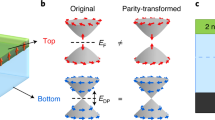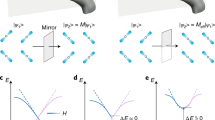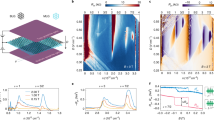Abstract
A recurring theme in topological matter is the protection of unusual electronic states by symmetry, for example, protection of the surface states in Z2 topological insulators by time-reversal symmetry1,2,3. Recently, interest has turned to unusual surface states in the large class of non-symmorphic materials4,5,6,7,8,9,10,11,12. In particular, KHgSb is predicted to exhibit double quantum spin Hall states10. Here we report measurements of the Hall conductivity in KHgSb in a strong magnetic field B. In the quantum limit, the Hall conductivity is observed to fall exponentially to zero, but the diagonal conductivity is finite. A large gap protects this unusual zero-Hall state. We theoretically propose that, in this quantum limit, the chemical potential drops into the bulk gap, intersecting equal numbers of right- and left-moving quantum spin Hall surface modes to produce the zero-Hall state. The zero-Hall state illustrates how topological protection in a non-symmorphic material with glide symmetry may lead to highly unusual transport phenomena.
This is a preview of subscription content, access via your institution
Access options
Access Nature and 54 other Nature Portfolio journals
Get Nature+, our best-value online-access subscription
$29.99 / 30 days
cancel any time
Subscribe to this journal
Receive 12 print issues and online access
$259.00 per year
only $21.58 per issue
Buy this article
- Purchase on Springer Link
- Instant access to full article PDF
Prices may be subject to local taxes which are calculated during checkout




Similar content being viewed by others
Data availability
All of the data displayed in the main text and Supplementary Information are available from S.H.L. (sihangl@princeton.edu) or N.P.O. (npo@princeton.edu) upon request.
References
Fu, L., Kane, C. L. & Mele, E. H. Topological insulators in three dimensions. Phys. Rev. Lett. 98, 106803 (2007).
Fu, L. & Kane, C. L. Topological insulators with inversion symmetry. Phys. Rev. B 76, 045302 (2007).
Qi, X. L., Hughes, T. L. & Zhang, S. C. Topological field theory of time-reversal invariant insulators. Phys. Rev. B 78, 195424 (2008).
Parameswaran, S. A. et al. Topological order and absence of band insulators at integer filling in non-symmorphic crystals. Nat. Phys. 9, 299–303 (2013).
Liu, C. X., Zhang, R. X. & VanLeeuwen, B. K. Topological nonsymmorphic crystalline insulators. Phys. Rev. B 90, 085304 (2014).
Shiozaki, K. & Sato, M. Topology of crystalline insulators and superconductors. Phys. Rev. B 90, 165114 (2014).
Young, S. M. & Kane, C. L. Dirac semimetals in two dimensions. Phys. Rev. Lett. 115, 126803 (2015).
Fang, C. & Fu, L. New classes of three-dimensional topological crystalline insulators: nonsymmorphic and magnetic. Phys. Rev. B 91, 161105 (2015).
Shiozaki, K., Sato, M. & Gomi, K. Z2 topology in nonsymmorphic crystalline insulators: Möbius twist in surface states. Phys. Rev. B 91, 155120 (2015).
Wang, Z. J., Alexandradinata, A., Cava, R. J. & Bernevig, B. A. Hourglass fermions. Nature 532, 189–194 (2016).
Schoop, L. M. et al. Dirac cone protected by non-symmorphic symmetry and three-dimensional Dirac line node in ZrSiS. Nat. Commun. 7, 11696 (2016).
Wieder, B. J. et al. Wallpaper fermions and the nonsymmorphic Dirac insulator. Science 361, 246–251 (2018).
Ma, J. et al. Experimental evidence of hourglass fermion in the candidate nonsymmorphic topological insulator KHgSb. Sci. Adv. 3, e1602415 (2017).
Liang, A. J. et al. Observation of the topological surface state in the nonsymmorphic topological insulator KHgSb. Phys. Rev. B 96, 165143 (2017).
Büttiker, M. Absence of backscattering in the quantum Hall effect in multiprobe conductors. Phys. Rev. B 38, 9375–9389 (1988).
Beenakker, C. W. J. & van Houten, H. Quantum transport in semiconductor nanostructures. Solid State Phys. 44, 1–228 (1991).
Dyakonov, M. I., Efros, A. L. & Mitchell, D. L. Magnetic freeze-out of electrons in extrinsic semiconductors. Phys. Rev. 180, 813–818 (1969).
Goldman, V. J., Shayegan, M. & Drew, H. D. Anomalous Hall effect below the magnetic-field-induced metal-insulator transition in narrow-gap semiconductors. Phys. Rev. Lett. 57, 1056–1059 (1986).
Mani, R. G. Influence of localization on the Hall effect in narrow-gap, bulk semiconductors. Phys. Rev. B 41, 7922–7925 (1990).
Nagaosa, N., Sinova, J., Onoda, S., MacDonald, A. H. & Ong, N. P. Anomalous Hall effect. Rev. Mod. Phys. 82, 1539–1592 (2010).
Acknowledgements
The research was supported by the Department of Energy (DE-SC0017863) and the Gordon and Betty Moore Foundation’s EPiQS initiative through grants GBMF4539 (to N.P.O.) and GBMF-4412 (to R.J.C.). The crystal growth and characterization were supported by the ARO MURI on topological insulators (contract W911NF-12-1-0461), and by the US National Science Foundation (grant DMR 1420541). The high-field experiments were performed at both the National High Magnetic Field Lab. NHMFL (Tallahassee) and at the Pulsed Field Facility (Los Alamos National Laboratory). NHMFL is supported by the National Science Foundation Cooperative Agreement no. DMR-1157490, the State of Florida and the US Department of Energy. The theory work was supported by grants to B.A.B. from the Department of Energy DE- SC0016239, Simons Investigator Award and NSF EAGER Award NOA - AWD1004957. B.S. is supported by the NSF STC ‘Center for Integrated Quantum Materials’ under Cooperative Agreement no. DMR-1231319.
Author information
Authors and Affiliations
Contributions
The experiment was planned by S.L., S.K., R.J.C., Z.W., B.A.B. and N.P.O. S.L. led the measurement effort with assistance from T.G. and M.H. The crystals were grown and characterized by S.K., K.S. and R.J.C. Theoretical support was provided by J.L., Z.W., B.A.B. and B.S. The manuscript was written by N.P.O. with contributions from all authors.
Corresponding author
Ethics declarations
Competing interests
The authors declare no competing interests.
Additional information
Publisher’s note: Springer Nature remains neutral with regard to jurisdictional claims in published maps and institutional affiliations.
Supplementary information
Supplementary Information
Supplementary Notes 1–10, Supplementary Table 1, Supplementary References 1–19, Supplementary Figures 1–15
Rights and permissions
About this article
Cite this article
Liang, S., Kushwaha, S., Gao, T. et al. A gap-protected zero-Hall effect state in the quantum limit of the non-symmorphic metal KHgSb. Nat. Mater. 18, 443–447 (2019). https://doi.org/10.1038/s41563-019-0303-x
Received:
Accepted:
Published:
Issue Date:
DOI: https://doi.org/10.1038/s41563-019-0303-x
This article is cited by
-
Magnetic freeze-out and anomalous Hall effect in ZrTe5
npj Quantum Materials (2022)
-
Progress and prospects in magnetic topological materials
Nature (2022)
-
Magnetic-field-induced robust zero Hall plateau state in MnBi2Te4 Chern insulator
Nature Communications (2021)
-
Topological materials discovery from crystal symmetry
Nature Reviews Materials (2021)



